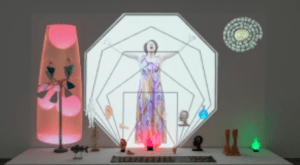Binary Code: Two Shows on Gender and Technology, Emily Watlington, δημοσίευση στο Art in America [19/8/2019]

Technology was supposed to be our big gender ender, at least according to Donna Haraway’s influential 1985 “Cyborg Manifesto.” Haraway imagined that machines might obviate biological reproduction and the gender binary along with it. But engineers trained artificial intelligence to reinforce their sexist views. They developed overtly feminine assistants like Alexa and Siri to be permanently available and completely subservient. In 2015, women made up only 25% percent of the American computing workforce. This is a total inversion of the situation prior to the 1980s: women ruled computers when programming was considered the menial fulfillment of commands rather than the shaping of our world.
Haraway’s manifesto laid the ground for cyberfeminism, a predominantly technopositivist movement of women who hoped technology—particularly the anonymity afforded by online communication—could liberate people from the constraints of gendered stereotypes. In 1991, the Australian collective VNX Matrix distributed their Cyberfeminist Manifesto for the 21st Centuryonline and in meatspace, buying ad space on billboards and handing out Xeroxes. It’s full of quips like “the clitoris is a direct line to the matrix.” One poster rendition of the manifesto was on view this past spring in “Producing Futures: An Exhibition on Post-Cyber-Feminisms” at the Migros Museum in Zurich. The manifesto was the point of departure for an exhibition of fifteen artists and collectives that explored the relationship between gender, technology, and art in the present, a time when positing technology as a savior is no longer viable.
Για περισσότερα δες εδώ.





